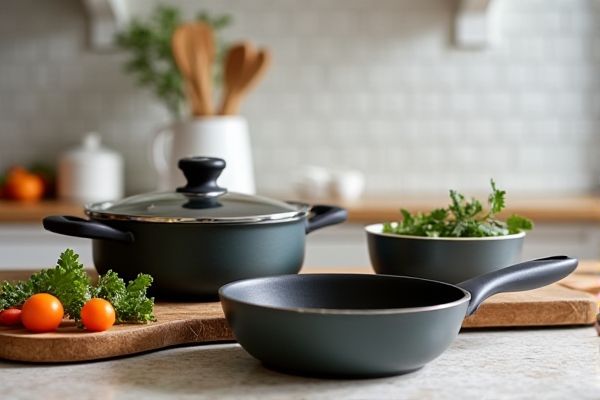
Ceramic cookware offers a non-toxic, scratch-resistant surface ideal for high-heat cooking, while nonstick cookware provides easy food release and straightforward cleanup but may wear out faster. Discover which option best suits your cooking style and kitchen needs by reading the rest of the article.
Table of Comparison
| Feature | Ceramic Cookware | Nonstick Cookware |
|---|---|---|
| Material | Natural ceramic coating over metal base | PTFE or Teflon-based synthetic coating |
| Heat Tolerance | Up to 450degF (232degC) | Up to 500degF (260degC) |
| Nonstick Performance | Good initially; may degrade faster | Excellent and durable nonstick surface |
| Health & Safety | Free of PTFE & PFOA; considered safer | Contains PTFE; avoid overheating to prevent toxic fumes |
| Durability | Less durable; prone to chipping | Highly durable with proper care |
| Maintenance | Hand wash recommended; avoid metal utensils | Hand or dishwasher safe; avoid abrasive tools |
| Environmental Impact | More eco-friendly; uses natural materials | Uses synthetic chemicals; environmental concerns exist |
| Price | Moderate to high | Low to moderate |
Introduction to Ceramic and Nonstick Cookware
Ceramic cookware features a natural, non-reactive surface derived from inorganic minerals, providing even heat distribution and scratch resistance ideal for healthy cooking. Nonstick cookware uses synthetic coatings such as polytetrafluoroethylene (PTFE) to prevent food from sticking, enabling easy release and minimal oil usage. Both types offer distinct advantages in durability, heat tolerance, and maintenance, catering to different culinary preferences and cooking techniques.
Material Composition: Ceramic vs Nonstick
Ceramic cookware features a natural mineral-based coating derived from sand and other inorganic materials, offering a non-toxic and environmentally friendly cooking surface. Nonstick cookware typically uses a synthetic polytetrafluoroethylene (PTFE) coating, such as Teflon, which provides excellent food release but may release harmful fumes if overheated. Choosing ceramic ensures a PTFE-free, metal-free option, while nonstick cookware excels in easy cleanup and low-fat cooking.
Heat Distribution and Retention
Ceramic cookware offers superior heat distribution due to its dense, inorganic material composition, ensuring even cooking and reducing hot spots. Nonstick cookware, often made with aluminum bases, heats up quickly but may experience uneven heat retention, affecting cooking consistency. Ceramic's ability to retain heat longer makes it ideal for slow cooking, while nonstick is better suited for quick, low-to-medium temperature cooking tasks.
Non-Toxicity and Safety Concerns
Ceramic cookware is non-toxic and free from harmful chemicals like PFOA, PTFE, and lead, making it a safer choice for health-conscious users. Nonstick cookware often contains synthetic coatings such as Teflon, which can release toxic fumes when overheated, posing potential health risks. Choosing ceramic cookware reduces exposure to toxic substances and supports safer cooking practices.
Cooking Performance and Versatility
Ceramic cookware offers excellent heat retention and even cooking, making it ideal for searing, frying, and slow-cooking a wide range of dishes without the risk of toxic fumes. Nonstick cookware excels in low-fat cooking and easy food release, perfect for delicate items like eggs and pancakes, but it typically has lower heat tolerance and may degrade faster under high temperatures. Both types provide versatile kitchen solutions, yet ceramic's durability suits high-heat techniques while nonstick prioritizes convenience and gentle cooking.
Durability and Lifespan
Ceramic cookware offers superior durability due to its scratch-resistant and non-porous surface, often lasting several years without losing effectiveness. Nonstick cookware typically has a shorter lifespan because its coating can degrade and peel after frequent use or exposure to high heat. Choosing ceramic cookware can extend your cooking investment by maintaining performance and safety over time.
Cleaning and Maintenance
Ceramic cookware features a smooth, non-porous surface that resists staining and allows for easy cleaning with mild detergent and a soft sponge, preventing scratches and maintaining its non-stick properties. Nonstick cookware typically requires gentle hand washing to preserve the integrity of its polymer coating, as abrasive cleaning tools and high heat can cause peeling and reduce lifespan. Both types demand careful maintenance by avoiding metal utensils and dishwasher use to extend durability and ensure optimal cooking performance.
Price Comparison and Value
Ceramic cookware generally costs more upfront than nonstick options but offers superior heat resistance and chemical-free cooking surfaces, enhancing long-term health benefits. Nonstick cookware is often more affordable initially, yet tends to have a shorter lifespan due to coating degradation from frequent use and improper care. Investing in ceramic cookware provides better value over time through durability and eco-friendly attributes despite the higher initial price.
Environmental Impact
Ceramic cookware is often favored for its eco-friendly composition, utilizing natural materials that reduce harmful chemical runoff compared to traditional nonstick coatings containing PTFE and PFOA, which may release toxic fumes during overheating. Your choice of ceramic over nonstick can lower environmental pollution because ceramic surfaces are more biodegradable and less reliant on synthetic chemicals. Selecting ceramic cookware supports sustainable manufacturing processes and decreases long-term ecological footprints linked to synthetic nonstick coatings.
Choosing the Right Cookware for Your Kitchen
Ceramic cookware offers a non-toxic, eco-friendly alternative with excellent heat retention and durability, making it ideal for searing and baking. Nonstick cookware, coated with materials like PTFE or ceramic, provides effortless food release and easy cleanup, perfect for low-fat cooking and delicate foods. Selecting the right cookware depends on your cooking style, maintenance preferences, and desire for chemical-free surfaces or convenience in cooking and cleaning.
 homyna.com
homyna.com